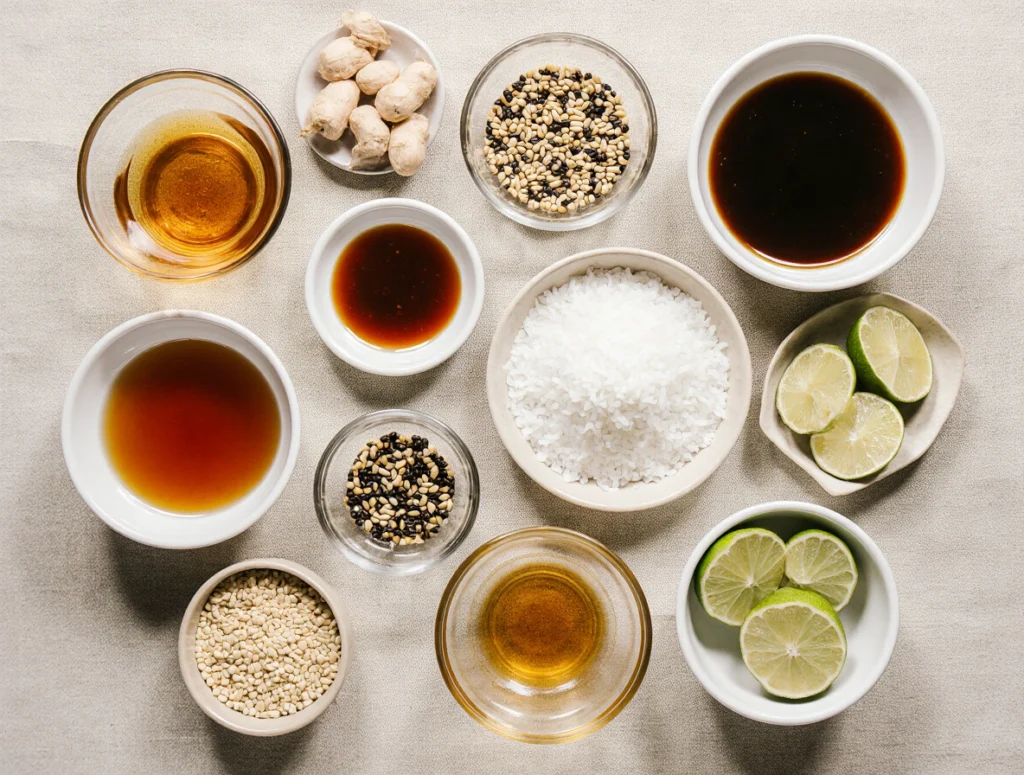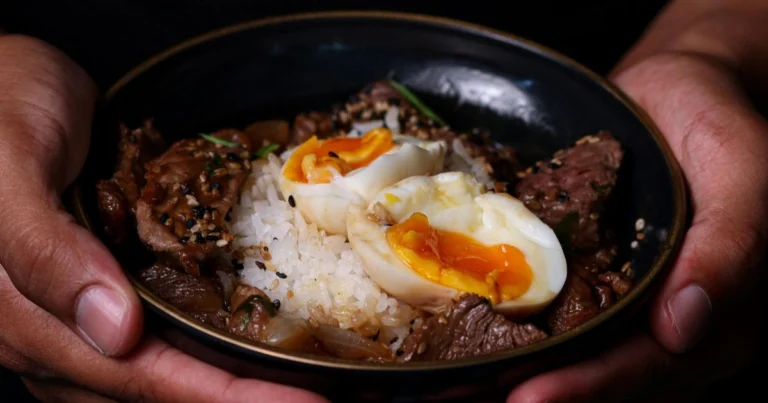The Best Asian Salad Dressing Recipe You’ll Ever Try (Ready in 5 Minutes!)
Table of Contents
A Flavor Journey in Every Drizzle
You know those moments when a simple bowl of greens suddenly feels like a restaurant masterpiece? When the crunch of lettuce meets a silky, tangy-sweet dressing that makes every bite feel alive? That’s exactly what this Asian salad dressing recipe is all about — quick, flavorful, and bursting with balance.
In just five minutes, you can create something that doesn’t just coat your salad — it transforms it. Whether you’re craving something light and healthy for lunch or need a zesty boost for your dinner bowl, this homemade Asian dressing is your new go-to secret.
What makes it special isn’t just the speed or simplicity — it’s the depth of flavor that lingers long after the last bite. You’ll taste the warmth of ginger, the brightness of lime, the nutty aroma of sesame oil, and the subtle sweetness that ties it all together.
And the best part? You don’t need fancy ingredients or culinary skills — just a few pantry staples, one bowl, and five minutes of your time.
Why You’ll Love This Asian Salad Dressing Recipe
This isn’t your average vinaigrette. It’s that perfect balance between comfort and freshness, crafted for real-life cooks like you. Here’s why you’ll want to make it again and again:
- Quick and easy: Done in under 5 minutes — no blender, no fuss.
- Flavor explosion: Every ingredient adds a layer — salty, sweet, tangy, and umami.
- Versatile use: Works wonders on salads, noodles, grains, or as a marinade.
- Healthier choice: No preservatives, no refined oils — just clean, natural goodness.
- Budget-friendly: Everything comes straight from your kitchen shelves.
Whether you’re meal-prepping for the week or trying to elevate your weekday salad, this dressing is that simple luxury you can make any time.
Ingredients for the Best Asian Salad Dressing Recipe
Before you begin, lay everything out on your counter. These are common, everyday ingredients — yet together, they create something extraordinary.


Your Flavor-Packed Ingredients Table
| Ingredient | Quantity | Purpose / Flavor Profile |
|---|---|---|
| Soy sauce | 2 tbsp | Salty umami base |
| Rice vinegar | 1½ tbsp | Tangy brightness |
| Sesame oil | 1 tbsp | Deep nutty aroma |
| Honey or maple syrup | 1 tbsp | Balances tang with sweetness |
| Fresh ginger (grated) | 1 tsp | Warm, spicy depth |
| Garlic (minced) | 1 clove | Savory intensity |
| Lime juice (optional) | 1 tsp | Adds citrusy lift |
| Sesame seeds | ½ tsp | Adds texture and nuttiness |
Ingredient Notes & Substitutions
- Use tamari instead of soy sauce for a gluten-free version.
- Replace honey with maple syrup or agave nectar for a vegan alternative.
- Swap rice vinegar for apple cider vinegar if you’re out — it adds a similar tang.
- Add a few drops of chili oil if you like a spicy kick.
How to Make Asian Salad Dressing (Step-by-Step Guide)
You’re just five minutes away from the most delicious salad upgrade ever. Here’s how to bring it all together:

Step 1 – Combine the Base
In a small bowl or jar, pour in your soy sauce, rice vinegar, and sesame oil. This trio forms the heart of the dressing — salty, tangy, and rich.
Step 2 – Add Sweetness and Aromatics
Mix in honey (or maple syrup) to soften the vinegar’s sharpness, then add grated ginger and minced garlic. You’ll smell the transformation instantly — that signature Asian aroma that hints at both comfort and adventure.
Step 3 – Blend It Smooth
Whisk it briskly with a fork, or better yet, shake it in a sealed jar. The shaking method gives it a silky texture and evenly emulsifies the oil and vinegar.
Step 4 – Taste and Adjust
This is where you make it yours.
- Add a splash more vinegar if you like extra tang.
- A bit more honey makes it smoother and sweeter.
- Or a touch of lime juice brightens everything beautifully.
Pro Tip:
Refrigerate for 10 minutes before serving — this helps the flavors meld into something truly magical.
Serving Suggestions and Creative Pairings
You’re not limited to salads here. This dressing works like a charm on almost everything.
Perfect Ways to Enjoy This Asian Dressing
- Classic green salad: Drizzle over mixed greens, cucumber, and shredded carrots.
- Noodle bowls: Toss it with soba or rice noodles for a cool, refreshing lunch.
- Marinades: Use it to marinate chicken, tofu, or shrimp — adds instant umami.
- Grain bowls: Pour over quinoa, rice, or bulgur for a light, tangy twist.
- Vegetable stir-fries: A quick splash after cooking enhances the depth of flavor.
Flavor Variations (Optional Add-Ins)
- Add a teaspoon of peanut butter for a creamy Thai-style twist.
- Stir in chili flakes or sriracha for spice lovers.
- Mix in orange juice or zest for a refreshing citrusy lift.
With these tweaks, you can turn one dressing into five different creations.
Storage Tips and Shelf Life
Homemade dressings don’t need preservatives — just a little care.
- Storage: Keep your dressing in a tightly sealed glass jar.
- Refrigeration: It lasts beautifully for up to 7 days.
- Before each use: Shake well to re-emulsify the ingredients (natural separation is normal).
- Avoid freezing: It affects the sesame oil’s texture and aroma.
This makes it perfect for weekly meal prep — you’ll have a burst of flavor ready whenever you need it.
Nutrition Information (Per Serving)
| Nutrient | Amount |
|---|---|
| Calories | ~80 kcal |
| Fat | 6g |
| Carbohydrates | 5g |
| Protein | 1g |
| Sugar | 4g |
| Sodium | 300mg |
Note: Using reduced-sodium soy sauce can cut the salt by nearly half without affecting taste.
🥢 Expert Tips for the Perfect Asian Salad Dressing
You might think making an Asian salad dressing recipe is as simple as mixing soy sauce and vinegar — but there’s a fine art to getting that perfect balance of salty, sweet, tangy, and umami. Here are some expert-backed tips to help you nail it every single time.
1. Taste as You Go — Balance Is Everything
The secret to a truly unforgettable dressing lies in adjustment. Start with the basic proportions, then taste after every mix.
- Too salty? Add a touch more honey or maple syrup.
- Too sweet? Add an extra splash of rice vinegar or lime juice.
- Lacking depth? A few drops of sesame oil or soy sauce bring back umami harmony.
Balance is personal — your palate is the best guide.
2. Use Fresh Aromatics for Real Flavor
Bottled ginger and pre-minced garlic might save you seconds, but they’ll cost you flavor.
Freshly grated ginger adds warmth and brightness, while minced garlic gives your dressing that signature savory punch. Together, they transform a good dressing into a great one.
Pro tip: Grate ginger with its skin on for a bolder, earthier aroma — and use a fine grater for the smoothest texture.
3. Choose High-Quality Sesame Oil
Not all sesame oils are created equal. The toasted variety brings a nutty, aromatic depth that defines a true Asian-style dressing.
When you open the bottle, you should smell rich roasted notes — that’s how you know it’s fresh. If it smells flat or rancid, it’s time for a new one.
For the richest flavor, store sesame oil in a cool, dark place and use it within six months.
4. Let It Rest Before Serving
Once you’ve whisked or shaken your dressing, let it sit for about 10 minutes. This short resting period allows the ingredients to marry — the soy, vinegar, and aromatics mingle into something beautifully cohesive.
If you can, chill it in the fridge for half an hour before drizzling — the result is smoother, more balanced, and incredibly refreshing.
5. Customize It to Match Your Meal
A great Asian salad dressing is flexible.
- Add peanut butter for a creamy Thai-style twist.
- Stir in chili oil or sriracha for a spicy version.
- Mix in orange juice or zest for a citrusy lift.
You can even double it as a marinade for tofu, chicken, or grilled vegetables.
The best part? It’s endlessly adaptable — no two batches ever need to taste the same.
6. Shake, Don’t Just Stir
For the smoothest, most emulsified texture, skip the whisk and use a jar with a tight lid.
Add all your ingredients, seal it, and shake vigorously for 10–15 seconds. This simple technique creates that glossy, perfectly blended consistency that clings to every leaf or noodle strand.
7. Make Ahead for Maximum Flavor
This dressing tastes even better the next day. The longer it sits (up to a week in the fridge), the more the ginger and garlic infuse the sauce.
Just remember to give it a good shake before using — natural separation is normal.
8. Don’t Overdo the Sesame Oil
Sesame oil is powerful — a little goes a long way. Too much can overwhelm the lighter notes from the vinegar or citrus.
Stick to the recommended amount, then adjust drop by drop if needed.
9. Add Texture for Extra Appeal
A sprinkle of toasted sesame seeds, chopped scallions, or crushed peanuts adds crunch and visual appeal. These small details give your salad that restaurant-quality look — and make every bite more exciting.
10. Keep It Fresh, Keep It Simple
The beauty of this dressing lies in its simplicity. Don’t overcomplicate it with too many ingredients or store-bought shortcuts. With just a few fresh pantry staples, you can create a dressing that feels authentic, healthy, and unbelievably flavorful.
✅ Quick Recap:
- Always balance sweet, salty, tangy, and umami flavors.
- Use fresh aromatics and high-quality sesame oil.
- Shake to emulsify, rest before serving, and store properly.
- Customize with add-ins to match your mood or meal.
When you follow these tips, your Asian salad dressing recipe won’t just enhance your salad — it’ll steal the spotlight on your table.
Common Mistakes to Avoid
Even simple recipes can go off-balance. Keep these in mind:
- Too much sesame oil can overpower everything — a little goes a long way.
- Skipping the sweet element leaves the dressing flat and overly acidic.
- Using old soy sauce can result in muted flavors.
- Not whisking enough leaves uneven texture and taste.
A good dressing is like music — every note needs to be heard, but none should drown out the others.
FAQ – Asian Salad Dressing Recipe Edition
What makes this Asian salad dressing different from others?
Unlike store-bought versions, this one uses simple, clean ingredients. The combination of soy sauce, rice vinegar, and sesame oil delivers authentic Asian flavor — perfectly balanced with a touch of sweetness.
Can I make this Asian salad dressing ahead of time?
Absolutely. It keeps beautifully in the fridge for up to a week and actually tastes better the next day.
Is this Asian salad dressing healthy?
Yes! It’s made with heart-healthy oils, natural sweeteners, and no additives — a great alternative to bottled dressings full of preservatives.
Can I make it vegan or gluten-free?
Definitely. Use maple syrup instead of honey and tamari instead of soy sauce for a completely vegan and gluten-free version.
What salads go best with this Asian salad dressing?
It pairs wonderfully with cabbage slaws, spinach salads, noodle salads, or Asian-inspired quinoa bowls. Honestly, it elevates anything you drizzle it on.
Conclusion – The 5-Minute Secret to Salad Bliss
You don’t need hours in the kitchen or a shelf full of exotic ingredients to create something special. This Asian salad dressing recipe proves that magic happens when simple things meet balance and intention.
The next time you’re craving something vibrant, skip the store-bought bottle and whisk this up yourself. You’ll taste the difference — the freshness, the harmony, the way it makes even plain greens feel gourmet.
So go ahead — grab your bowl, shake your jar, and drizzle your masterpiece. Your taste buds (and your salads) will thank you.
Call to Action
👉 Love this recipe? Bookmark it, share it with your foodie friends, or pin it to your salad board for later inspiration.
For more quick and healthy dressings, explore our full collection of homemade vinaigrettes and Asian-inspired recipes — because every salad deserves a touch of flavor perfection.







